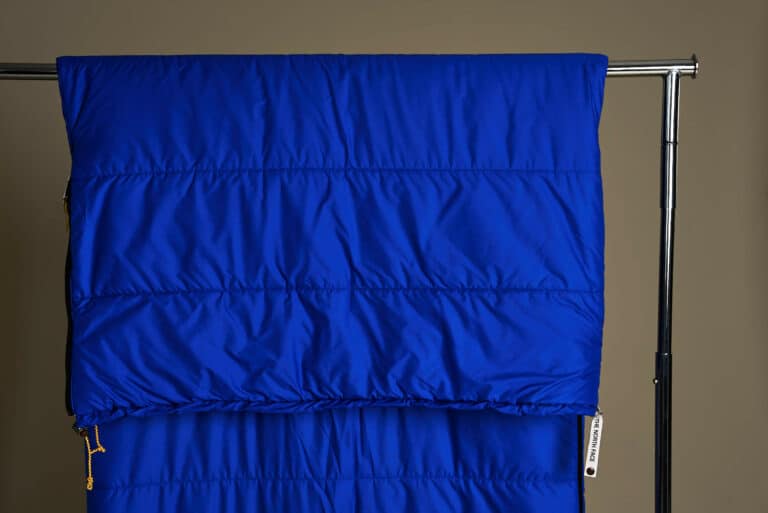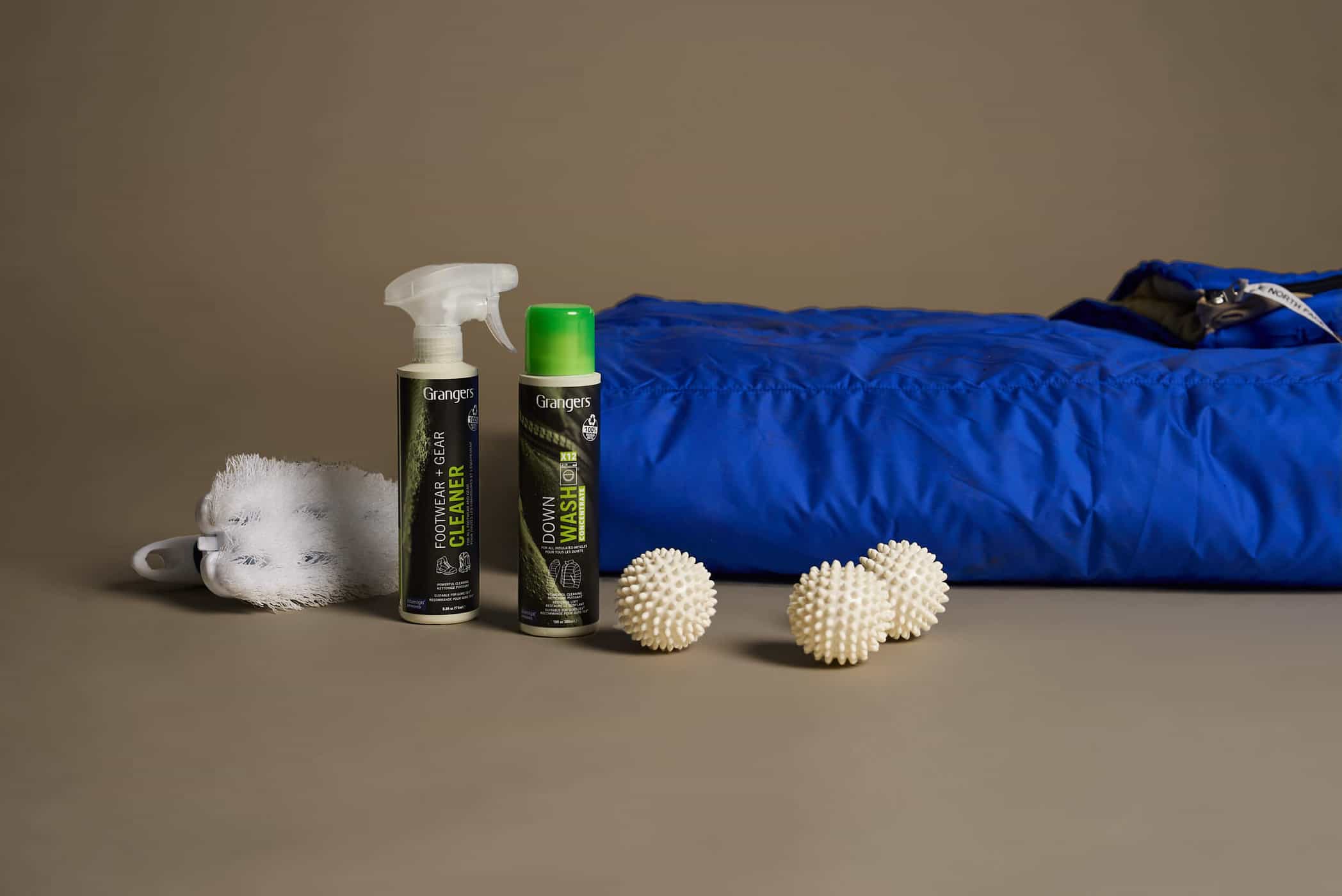Why Washing a Sleeping Bag is Important
Regularly washing your sleeping bag helps remove dirt, sweat, body oils, and other contaminants that can accumulate over time. This not only keeps your bag smelling fresh but also maintains its insulating properties, ensuring a comfortable and hygienic sleep environment on every adventure. Ideally, you should wash your sleeping bag at least once a year, or more frequently if it becomes visibly soiled.
Brief Overview of Washing Steps
Before diving into the details, let’s consider a bird’s eye view of the steps involved in washing a sleeping bag:
- Things to do before washing sleeping bag
- Wash sleeping bag
- Dry sleeping bag
- Down sleeping bag washing tips
1. Check the Care Label
Before washing your sleeping bag, always refer to the care instructions on the label. It’s important to note that different types of bags may require different cleaning treatments due to variations in materials and construction. Here are some common sleeping bag types and how to gently clean them.
Down Sleeping Bags
Filled with natural down feathers, down sleeping bags provide excellent insulation thanks to their loft. Due to the delicate nature of down, however, special care is required when washing it. The care label will provide specific instructions on the type of detergent to use, water temperature, and drying techniques. Follow these instructions religiously. Additionally, make it a habit to always turn the sleeping bag inside out before washing it, and zip it closed.
Synthetic Sleeping Bags
A synthetic sleeping bag is filled with manmade fibers that mimic the lightweight, insulating properties of down. These are generally more durable and easier to care for compared to down sleeping bags. The care label will indicate whether it can be machine washed or if it requires hand washing. Generally, you’ll want to start by turning your sleeping bag inside out and zipping it shut.
Waterproof/Breathable Sleeping Bags
Most sleeping bags are designed with waterproof and breathable materials, making them suitable for damp or wet environments. These bags often have specialized care instructions, such as using specific detergents to maintain their waterproof properties. The care label will provide information on how to clean and maintain the waterproof features.
Follow the care instructions for your specific type of sleeping bag to ensure you don’t inadvertently damage the materials or compromise the insulation. Got a down sleeping bag? Not to worry—below, we discuss additional tips and considerations for washing it.
By understanding the specific requirements of your sleeping bag type, you can tailor your cleaning approach to ensure best results and maintain the longevity of your gear. Following the manufacturer’s recommendations is essential to preserve the integrity and performance of your sleeping bag, allowing you to enjoy many comfortable nights of sleep in the great outdoors.

2. Spot Clean
If your sleeping bag has any noticeable stains, it’s best to spot clean them before proceeding with a full wash. Use a gentle detergent and a soft cloth or sponge to target the stains directly. Gently blot the stained area without rubbing vigorously, as this may damage the fabric.

3. Daily Maintenance
What’s more, if you have a wet sleeping bag after a night in the woods, air dry it as soon as possible. This reduces the chance of mold and helps preserve your bag’s insulating loftiness. Also, make sure to shake out your sleeping bag daily while on the trail—small branches can accumulate in the footbox and eventually lead to tears and holes in the sleeping bag’s shell.
4. Choose a Suitable Detergent
Selecting the right detergent is essential for washing your sleeping bag effectively. For down-filled sleeping bags, opt for a gentle, down-specific detergent. Synthetic-filled bags can be washed with a regular mild detergent. Avoid using fabric softeners or bleach, as they can harm the insulation and fabric.
Steps to Wash a Sleeping Bag
Hand Washing Instructions
- Fill a bathtub or large sink with lukewarm water.
- Add the appropriate amount of detergent according to the instructions on the detergent packaging.
- Submerge the bag in the water and gently agitate it to ensure even distribution of the detergent.
- Let the sleeping bag soak for about 15 minutes to allow the detergent to penetrate the fabric and remove any dirt or odors.
- Gently scrub any particularly soiled areas with a soft sponge or cloth. Be careful not to scrub too vigorously, as this may damage the fabric or insulation.
- Drain the soapy water and rinse the sleeping bag thoroughly with clean water until all the detergent is removed.
- Press the sleeping bag gently to remove excess water. Avoid wringing or twisting the bag, as this can deform the insulation and tear the shell.
- If necessary, repeat the rinsing process until the water runs clear and there are no traces of detergent left.
Machine Washing Instructions
When it comes time to machine wash your sleeping bag, we recommend using a front-loading washing machine instead of a top-loading one. Here’s why:
Front-Loading Machines
Front-loading washing machines are designed with a horizontal drum that rotates, allowing the sleeping bag to move more freely during the wash cycle. This gentle agitation helps to clean the sleeping bag without putting excessive stress on the insulation. The horizontal drum also reduces the risk of the sleeping bag getting tangled or damaged during the washing process.
Top-Loading Machines
In contrast, top-loading machines typically have a vertical drum and an agitator in the center. While they can still be used to wash sleeping bags, they may not provide as gentle a wash as front-loading machines. The agitator can create more friction, potentially causing the insulation to clump or shift. Additionally, the limited space in a top-loading machine may restrict the sleeping bag’s movement, leading to less effective cleaning.
When using a front-loading machine, follow these steps for machine washing your sleeping bag:
- Place the bag in the machine, ensuring there is enough space for it to move freely during the wash cycle. Avoid overloading the machine, as this can impact the cleaning efficiency.
- Add the appropriate amount of detergent based on the size of your bag and the manufacturer’s recommendations. Using too much detergent can leave residue, while using too little may not adequately clean the bag.
- Set the washing machine to a gentle cycle with warm water. The warm water helps enhance the cleaning process by loosening dirt and oils from the fabric.
- Start the wash cycle and allow it to complete. During the cycle, the bag will be gently agitated and cleaned.
- Once the wash cycle is finished, it’s advisable to run an additional rinse cycle to ensure all the detergent is gone. This prevents any detergent residue from affecting the insulation or causing skin irritation during future use.
By opting for a front-loading machine and following these machine washing instructions, you can effectively clean your bag while minimizing the risk of damage or compression to the insulation.

Tips for Getting the Best Results
Stain Removal
For stubborn stains that haven't been completely eliminated, you can try spot treating them with a stain remover specifically designed for the type of fabric in your bag. Follow the instructions on the stain remover product carefully to avoid damaging the fabric.
Sleeping Bag Liner
If you often find the inside of your bag getting dirty or smelly, then you may want to consider pairing it with a liner. Not only will this add several degrees of warmth, it’ll also keep your bag cleaner.
Drying a Sleeping Bag
Air Drying
The best way to dry a sleeping bag is air drying. Lay it flat or hang it upside down in a well-ventilated area away from direct sunlight or heat sources. This will prevent damage to the fabric and insulation.
Tumble Drying
If you need to speed up the drying process, you can tumble dry the sleeping bag on low heat. However, it’s crucial to periodically remove the bag from the dryer and fluff it up by hand to prevent clumping and maintain its loft.

Stuff and Store a Sleeping Bag
Properly stuffing and storing your sleeping bag is crucial for maintaining its loft, insulation, and overall performance. Here’s a guide on how to effectively stuff and store your sleeping bag:
- Clean and Dry: Before storing your sleeping bag, make sure it’s thoroughly clean and completely dry. Washing and drying it according to the instructions discussed earlier will ensure it’s in the best condition for storage.
- Loosely Stuffing: Start by loosely stuffing your sleeping bag into its storage sack or a larger breathable sack. Avoid folding it tightly, as this can compress the insulation and decrease its loft. Instead, gently push and stuff the sleeping bag into the sack, allowing it to retain its natural loft.
- Storage Location: Choose a dry and cool storage location for your sleeping bag. Avoid areas prone to moisture, such as basements or damp closets, as this can lead to mold or mildew growth. Ideally, store it in a well-ventilated area where the temperature remains relatively stable.
- Avoid compression: Avoid leaving your sleeping bag in a compressed state for extended periods. Compression can flatten the insulation and reduce its effectiveness. If your sleeping bag came with a larger storage sack or if you’re using a larger breathable sack, opt for that instead of tightly compressing it in a smaller stuff sack.
- Hang or Lay Flat: If you have space, consider hanging your sleeping bag or laying it flat in the storage area. Hanging allows the insulation to maintain its loft and prevents any potential creases or folds that could damage the fabric. If hanging isn’t feasible, laying it flat is the next best option.
- Air Out Periodically: Occasionally, take your sleeping bag out of storage and air it out. This helps prevent any musty odors and allows the insulation to breathe. Hang it outside or lay it flat in a well-ventilated area for a few hours before returning it to storage.
By following these steps, you can ensure that your bag remains in excellent condition during storage and is ready for your next outdoor adventure. Properly stuffed and stored, your sleeping bag will continue to provide you with cozy and comfortable nights of sleep under the stars.

Down Sleeping Bag washing Tips
- Detergent: Use a gentle, down-specific detergent for washing down bags. This type of detergent helps maintain the loft and integrity of the down insulation. For synthetic sleeping bags, a regular mild detergent is sufficient.
- Water Temperature: Wash a down sleeping bag in cold water to prevent the down from clumping together. Synthetic sleeping bags can be washed in warmer water, as they are more resilient to temperature variations.
- Drying: Down sleeping bags require extra care during the drying process. Set your dryer to low heat and add clean tennis balls or dryer balls to help fluff the insulation as it dries. Synthetic sleeping bags can be dried on low to medium heat without the need for additional items.
- Storage: To preserve the loft of down insulation, store down sleeping bags in a dry and uncompressed state. Avoid packing them tightly for extended periods.
Washing your sleeping bag is an important part of its maintenance routine. By following the step-by-step guide provided in this article, you can ensure that your sleeping bag stays clean, fresh, and in optimal condition. Remember to check the care label, choose the appropriate detergent, and follow the specific instructions for down and synthetic sleeping bags. With proper washing and drying techniques, your sleeping bag will provide you with a comfortable and cozy sleep for years to come.








